Roger J. Wendell
Defending 3.8 Billion Years of Organic EvolutionSM


"We never know the worth of water till the well is dry." - English Proverb(My page about Climate Change
might be of interest to you too!)

|
Click Here for my page on Climate Change... |
"Though the scientific consensus that humans are the principal cause of global warming grows stronger every month, to forecast trouble ahead for the Colorado River basin, one does not have to get into causes. Global warming is well under way in the western United States and, regardless of the cause it will continue for decades. Nothing that the West can do in the short run to reduce greenhouse gas emissions will have any effect on the Colorado River. The supply of it water is going to fall; our best bet is to focus on demand. But that will take a degree of political will and leadership seldom seen in hydraulic societies."
"We've known for decades that the hydrology of the West is changing, but for much of that time people said it was because of Mother Nature and that shewould return to the old patterns in the future. But we have found very clearly that global warming has done it, that it is the mechanism that explains the change and that things will be getting worse."
(Click on any of this page's "Thumbnail" images for a larger view)
"Water, water, water... There is no shortage of water in the desert but exactly the right amount, a perfect ratio of water to rock, of water to sand, insuring that wide, free, open, generous spacing among plants and animals, homes and towns and cities, which makes the arid West so different from any other part of the nation. There is no lack of water here, unless you try to establish a city where no city should be."The Devlopers, of course - the politicians, businesssmen, bankers, administrators, engineers - they see it somewhat otherwise and complain most bitterly and interminably of a desperate water shortage, especially in the Southwest. They propose schemes of inspiring proportions for diverting water by the damful from the Columbia River, or even from the Yukon River, and channeling it overland down into Utah, Colorado Arisona and New Mexico.
"What for? 'In anticipation of future needs, in order to provide for the continued industrial and population growth of the Southwest.' And in such an answer we see that it's only the old numbers game again, the monomania of small and very simple minds in the grip of an obsession. They cannot see that gowth for the sake of gowth is a cncerous madness, that Phoenix and Albuquerque will not be better cities to live in when their populations are doubled again and again. They would never understand that an economic system which can only expand or expire must be false to all that is human."

"In the West whiskey is for drinking; water is for fighting."
- Mark Twain

|
Click Here for my fish, fishing, oceans and water life page... |

|
"Imagine the rare, almost-forgotten pleasure of dipping a cup into a river - not a stream but a river - and drinking the water at once, without hesitation, without fear."
|
"Powell could not have foreseen that giant concrete dams larger than the pyramids would impound reservoirs nearly two hundred miles long. That hydropower dams would generate the electricity to pump water thousands of feet vertically and send it hundreds of miles laterally through complex networks of pumps, pipelines, canals, and siphons. That the landowners who benefited would not be the local farmer and rancher, but giant agribusinesses and absentee corporations who owned thousands and tens of thousands of acres. That the principal crop on federally irrigated lands would be food for someone else's cattle. The hydraulic society of the American West became and remains the opposite of everything for which John Wesley Powell, Thomas Jefferson, and Francis Newlands stood."

Did You Know?
Click Here for the Grist Magazine perspective on the growing world-wide water shortage.

Food and Water
In late 2001 I heard a radio broadcast by John Robbins (Of Baskin-Robbins ice cream fame) talking about how much water it takes to grow a pound of various food types. Although I was in my car, I was able to scribble down a few notes on what he said:
Fatehpur Sikri, India
Darwin, Australia23 gallons of water per pound of lettuce 49 gallons of water per pound of apples
70 gallons of water per pound of grapes
5,214 gallons of water per pound of beef
He added that gallon containers holding all the water needed for a pound of beef could be stacked a mile high! - Roger, Fall 2001

Some Headlines
A few excerpts from the article:
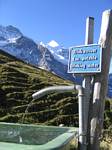 Switzerland |
Levels Falling Inch A Day By Katy Human Denver Post Staff Write Monday, November 8, 2004, p. 1B A couple excerpts from the article:
|

Western Water Wars and the Great Drought of 2002:
Out here in the West, water can be a contentious issue - if our cows aren't defecating in it, then we're stealing it from Native Americans, neighboring cities or a national forest. Of course water conservation is out of the question - out west we insist on Bluegrass lawns in the desert, casino fountains as big as Rhode Island, and wet streets for that early morning jog or drive to the office.Here's an example of a western water war that was brewing around the time of Y2K. The city of Aurora, Colorado (where I lived for 30 years) is fond of growing at the water expense of rural mountain areas. Here are a few photos off of U.S. Highway 285, in central Colorado, where the City of Aurora is coveting Park County water nearly 50 miles away...
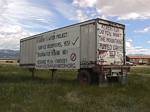
|
|
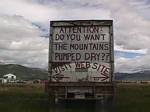
|
|
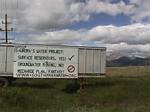
|

|
Click Here for more on the Aurora water battle... |
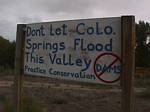
|
|
Here's a photo I took on a rainy mountain day in the summer of 2003. Looks like Colorado Springs has joined other cities in the water "Bad Neighbor Policy" campaign... |

Drought:
Although they'd never consider restrictions on growth and new water taps, Denver and other Colorado municipalities instituted strict water restrictions in the summer of 2002. By summer's end lawn watering, car washing, and sidewalk spraying were banned for most of Colorado's population. Although small sacrifices, in the grand scheme of things, it nevertheless points out how huge and wasteful Colorado's population has become.The Forecast Statistics web page for Colorado's Natural Resources Conservation Service (www.co.nrcs.usda.gov/ ) had this to say late in the summer of 2002:
"In the Colorado, Platte, Arkansas, and Rio Grande basins, water year 2002 will probably have the reputation of being the driest on record for many, many years to come. Even records set during the dry year of 1977 will fall by the wayside by the time September 30th rolls around." They added, "Not one acre of the Colorado - Platte - Arkansas - Rio Grande geographical area has been spared from the drought monster this year!"
So, what's the solution for Colorado and other Western states? To me it certainly isn't more dams! The ones we've got now can't be filled so why build more? The best idea would be some self restraint in the form of growth control and conservation. Bluegrass lawns and giant subdivisions just don't cut it anymore...

Rainwater Harvesting:
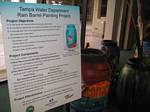
|
With really huge water bills, at my own house west of Denver, I was already thinking of ways to harvest the rainwater that usually just pours down my gutters, driveway and street - only to pick up all kinds of oils and chemicals as it makes its way to the storm drains, drainages, creeks and rivers flowing away from Colorado. In a natural environment I, personally, would be opposed to capturing or diverting large quantities of water as it is so vital to the habitat and wildlife that surrounds it. But, here in the city, this runoff is mostly wasted and can probably be used to lessen our dependence on aquifer mining, dams, wells and other storage schemes outside of our towns and neighborhoods. |
*In the October & November 2006 issue of Home Power magazine Doug Pushard wrote about his "Free Rain" High-Tech, Hands-Off rainwater collection system. Found on pages 70-74, Pushard provides indepth detail about the construction and automation of his Austin, Texas system...

Some Thoughts on Fluoride:

|
O what an endless worke have I in hand,
To count the seas abundant progeny, Whose fruitfull seede far passeth those in land. Spenser: The Faerie Queene, Book IV, Canto XII (1589) |
"A lake is the landscape's most beautiful and expressive feature. It is the earth's eye; looking into which the beholder measures the depth of his own nature."
- Henry David Thoreau |

Commercial Conservation:

|
I'm always skeptical whenever conservation efforts are being pushed for business or capitalistic ideals - to me, money is usually a poor motivator when it comes to things that are really important in life. Nevertheless, these little hotel water conservation cards seem to be pointing us in the right direction. I started encountering them, more and more frequently, in the early 2000s all throughout the U.S. and even in other parts of the world. It only makes sense that, while traveling, we reduce washing and water use enough to promote conservation yet maintain sanitation standards. I know in my own home I never wash sheets and towels, on a daily basis, unless absolutely necessary. So, if I'm staying in a hotel for a few days why would I act differently? |

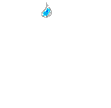
|
Measuring Water Volume: |
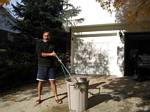 Measuring flow & volume |
For the many years we lived on Green Mountain I wondered about our water pressure and volume. Because we live on the side of the mountain our pressure, to me, seemed really high with water arching ten feet into the air anytime a garden hose was turned on. Our water supplier came out to test the system and assured me the pressure was within acceptable limits.
On October 1st, 2006 I decided to measure the flow, directly out of my garden hose, by timing how long it took to fill a garbage can. In this case (photo at left) it took exactly two minutes and 10 seconds to fill the container to its brim. Unfortunately, I couldn't find the container's capacity inscribed anywhere on it or the lid! So, I provided my son with the unit's measurements (19 inch lid, 15 inch bottom, 25 inches deep - inside measurements and uniformly tapered from top to bottom...) and he came up with the following: "3.3 Cubic Feet in volume, which is about 24.6 gallons. Soooo if you paid for a 25 gallon one, you got ripped!" "Anyhooo, this works out to a flow rate of about 11 gallons a minute, or 0.025 cubic feet per second, and if you like metric it's around 43 litres a minute." "The secret to the trash can calculation is to assume that it has been made from one large cone, with the pointy part chopped off. From the numbers you gave me you can compute the angle of taper, in this case about five degrees from the normal, and then use that to compute the height of the parent cone, something like 120 inches. Compute the volume of the cone to cut off 120: minus 25 inches of the trashcan cone, times the smaller radius (17/2) squared times pi/3, and subtract it from the volume of the parent cone 120 times the bigger radius of the trashcan (19/2) squared times pi/3. Then you get your result. At the end of course I realized I could just look online for trashcans of similar dimensions and learn that it was probably a 25 gallon can. Of course the calculation was fun in itself." |

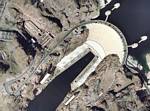 |
I've never been too wild about dams. My earliest encounters with them enforced my belief that they were wasteful plugs of cement that either stopped the salmon from running or backed water up magnificent canyons. Then, of course, as I grew older I learned they also cost a lot of money, filled with sediment, and brought too many people to a landscape that couldn't sustain them in countless ways (golf courses, casino water fountains, car washes, swimming pools, the list is endless...)
- Roger J. Wendell |
Dam Facts:

Water: A Short CV
by Robert M. Hazen in his book,
The Story of Earth (The First 4.5 Billion Years,
From Stardust to Living Planet), pp. 80-82
"Such polarity in water's molecules accounts for many of its distinctive properties. Polar water is super solvent, because its positive and negative ends exert strong forces that can pull apart other molecules. Consequently, table salt, sugar, and many other ingredients dissolve rapidly in water. Most rocks take a bit longer to dissolve, but over millions of years, the oceans have become rich in almost all the chemical elements. (As a consequence, every cubic mile of ocean water holds about four hundred pounds of gold - more than $10 million worth at the precious metal's recent high value, if only we had the technology to extract it.) This unparalleled ability of water to dissolve and transport other chemicals also makes it an ideal medium for the origins and evolution of life. All life on Earth, and perhaps all life in the cosmos, depends on water.""The polarity of water molecules causes them to bond strongly to one another: the positive side of one molecule attracts the negative sides of other molecules. Consequently, ice is an unusually strong molecular solid (a fact you'll not soon forget if you've ever fallen hard while ice-skating). Usually strong intermolecular bonding also results in water's unusually high surface tension - a fascinating property that allows small insects literally to walk on water. Surface tension also leads to capillary action, which causes water to rise through the stems of vascular plants and allows trees to soar hundreds of feet above land. Rounded raindrops, pulled together by the strong mutual attraction of water molecules, are yet another manifestation of surface tension and a vital link maintaining Earth's unusually rapid water cycle. Nonpolar volatile molecules like methane and carbon dioxide can't form such droplets. They would just float in the atmosphere as ultrafine, pervasive mist, so "rain' would be unknown on a planet dominated by those atmospheric gases."

Waterfalls Described:

Hoover Dam
Water Waypoints

For personal safety, and just for the fun of it, I usually take a GPS "reading" on the top of each peak, at the trailhead, or some other interesting point or curiosity along the way. WARNING: I cannot guarantee the accuracy of these waypoints as my own GPS bounces around a lot or I simply take an incorrect reading! Please rely on a more accurate source for your Waypoints! That being said, I still enjoy "cataloging" Waypoints and I keep a bunch of other locations, from around the world, on my 12ers, 13ers, 14ers, Waypoints, and other pages...
| Hoover Dam - on top between Arizona and Nevada on the state line (05-03-2014) | N 36° 00.978" | W 114° 44.234' | 385 feet | 117 metres |

Links:
|
|

 Back to Roger J. Wendell's Home Page...
Back to Roger J. Wendell's Home Page...
Abbey |
About |
Blog |
Contacting
Me |
Copyright |
Disclaimer |
Donate |
Guest
Book |
Home |
Links |
Site
Index |
Solutions |
Terms,
Conditions
and
Fair
Use |
What's
Changed
or
New?
Copyright
© 1955 -